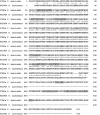Identification of a novel Plasmopara halstedii elicitor protein combining de novo peptide sequencing algorithms and RACE-PCR
- PMID: 20459704
- PMCID: PMC2881003
- DOI: 10.1186/1477-5956-8-24
Identification of a novel Plasmopara halstedii elicitor protein combining de novo peptide sequencing algorithms and RACE-PCR
Abstract
Background: Often high-quality MS/MS spectra of tryptic peptides do not match to any database entry because of only partially sequenced genomes and therefore, protein identification requires de novo peptide sequencing. To achieve protein identification of the economically important but still unsequenced plant pathogenic oomycete Plasmopara halstedii, we first evaluated the performance of three different de novo peptide sequencing algorithms applied to a protein digests of standard proteins using a quadrupole TOF (QStar Pulsar i).
Results: The performance order of the algorithms was PEAKS online > PepNovo > CompNovo. In summary, PEAKS online correctly predicted 45% of measured peptides for a protein test data set.All three de novo peptide sequencing algorithms were used to identify MS/MS spectra of tryptic peptides of an unknown 57 kDa protein of P. halstedii. We found ten de novo sequenced peptides that showed homology to a Phytophthora infestans protein, a closely related organism of P. halstedii. Employing a second complementary approach, verification of peptide prediction and protein identification was performed by creation of degenerate primers for RACE-PCR and led to an ORF of 1,589 bp for a hypothetical phosphoenolpyruvate carboxykinase.
Conclusions: Our study demonstrated that identification of proteins within minute amounts of sample material improved significantly by combining sensitive LC-MS methods with different de novo peptide sequencing algorithms. In addition, this is the first study that verified protein prediction from MS data by also employing a second complementary approach, in which RACE-PCR led to identification of a novel elicitor protein in P. halstedii.
Figures




References
LinkOut - more resources
Full Text Sources

